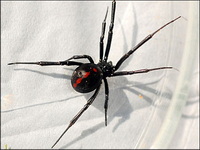
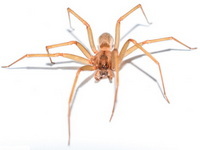
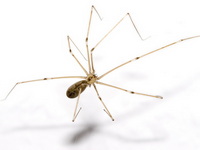
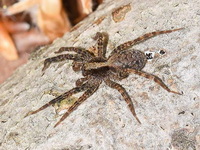
Spider Info
Missouri is home to over 300 different species of spiders. The most common groups include orb weavers, crab, jumping, and wolf spiders. These groups are distinguished by the size and shape of their bodies, the structure of their legs and other appendages, and the size and relative position of their eyes. Tarantulas are not very abundant in Missouri but they can occasionally be found in the southern part of the state. The brown recluse and the black widow are the only two spiders in Missouri that are considered to be serious threats to human health. Most other species are considered nuisance pests when found in and around homes.
While many people have arachnophobia, the vast majority of spiders are actually harmless to us. Spiders are very sensitive to vibration and their first instinct is typically to run and hide when disturbed. They are not aggressive and won’t bite unless severely provoked. The majority of accidental bites occur when they’re hiding in clothing or shoes and are squished by the wearer.
Black Widow
The black widow is one of two poisonous spiders found in Missouri.
The female black widow is jet black with a red hourglass-shaped marking on the underside of her abdomen. The abdomen is generally much larger than the cephalothorax. Males are much smaller than females and usually have yellow and red bands and spots over the body. Immature black widows have similar markings. Only the females are venomous.
Black widows are shy and nocturnal creatures that live in undisturbed locations, such as under trash, litter, boards, and rocks. They can also be found in little-used buildings, crawl spaces, cellars, and basements. Black widows typically construct an irregular web in spaces between objects and do not leave their webs unless disturbed. Bites from black widows usually occur when humans come into direct contact with the web or when the spider is unknowingly pinned against their skin.
Black widow spider venom affects the nervous system. A bite from a black widow spider can cause severe pain at the bite site, as well as dizziness, nausea, blurred vision, and difficulty breathing. If you are bitten by a black widow spider, you should seek medical attention immediately. Fatalities from black widow bites are rare, and recovery is usually quick and complete.
Black widows are found worldwide and are most recognized for the red hourglass shape on the underside of their abdomen. Their common name comes from the popular belief that the female eats the male after mating, although this rarely happens in nature. Although fatalities are rare, the black widow’s venom is reported to be 15 times stronger than a rattlesnake’s and can cause muscle aches, nausea, and difficulty breathing.
If you see webs in your home or on your property, or silken sacs in doorways, it could be a sign of a black widow spider infestation. Black widow spiders typically build messy and irregular webs near ground level. If you see any of these signs, you should contact us to remove the spiders and their webs. Black widow spiders are venomous and their bites can be serious, so it is important to take action quickly if you suspect an infestation.
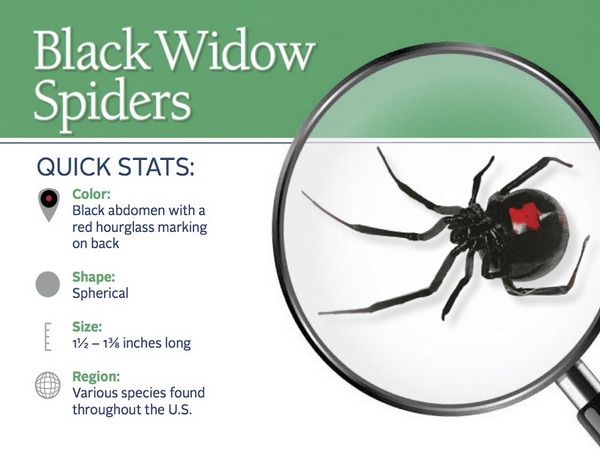
Black Widow
Brown Recluse
The brown recluse spider is named for its reclusive habits and light brown color. It is typically found in dry, cluttered, and undisturbed spaces, such as basements, closets, and woodpiles. Brown recluse spiders are attracted to these areas because they provide a supply of insects and other small organisms, which they prey on. One study found that brown recluse spiders were present in about 70% of homes sampled in Missouri.
The recluse is a venomous spider found in the Midwest and Southeast of the United States. It is a small, light to dark brown spider with a violin-shaped marking on its back. Brown recluse spiders are secretive and prefer to live in warm, dry, and dark places, such as woodpiles, basements, and closets. They bite when they feel threatened, and the bite can develop into a painful, open sore that can take weeks to heal. Most bites occur when someone puts on a glove or a shoe in which a spider is hiding. In some cases, the bite can cause a severe allergic reaction which can be fatal, especially in children, the elderly, and people with preexisting medical conditions. If you think you have been bitten by a brown recluse spider, seek medical attention immediately.
Both male and female brown recluse spiders are venomous. The effects of a brown recluse bite vary depending on the amount of venom injected and the victim’s sensitivity. Some people experience no symptoms, while others may experience a painful reaction that can include a stinging sensation, intense pain, swelling, and a white blister. In some cases, the tissue around the bite may die and slough away, leaving a sunken ulcerated sore. The typical reaction is mild and covers an area less than the size of a dime. However, in rare cases, the sore can cover a larger area. Medical attention should be obtained as soon as possible after a bite occurs. Prompt medical attention can prevent severe reactions and lessen the long-term effects. Healing takes place slowly, requiring six to eight weeks. Fatalities are rare.
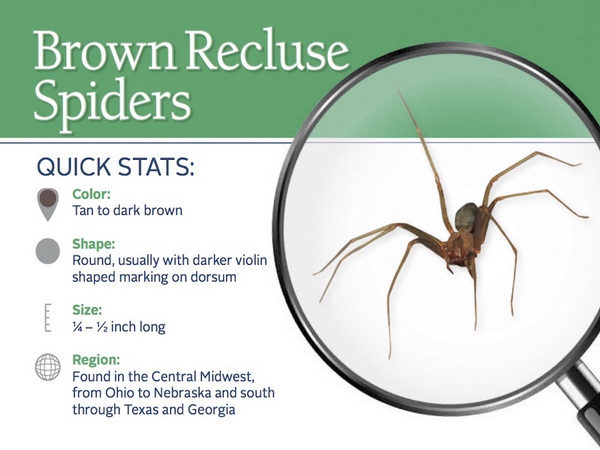
Brown Recluse
Spiders are often feared and misunderstood, but they actually play an important role in the environment. They are predators of insects, and they help to control populations of pests. While some spiders can be venomous, the vast majority are harmless to humans. In fact, many spiders are beneficial to humans, as they help to keep our homes and gardens free of insects. We should learn to appreciate spiders for the important role they play in our world.
In Missouri, it is common to see daddy longlegs and wolf spiders in homes. Daddy longlegs are not spiders, but they are beneficial arthropods that should be tolerated. Wolf spiders are also beneficial, as they hunt and eat other insects, including brown recluse and black widow spiders. Both daddy longlegs and wolf spiders are harmless to humans.
Houseman, Richard M., Department of Entomology. “Spiders.” Extension.missouri.edu, University of Missouri Extension, 2023, https://extension.missouri.edu/g7386.